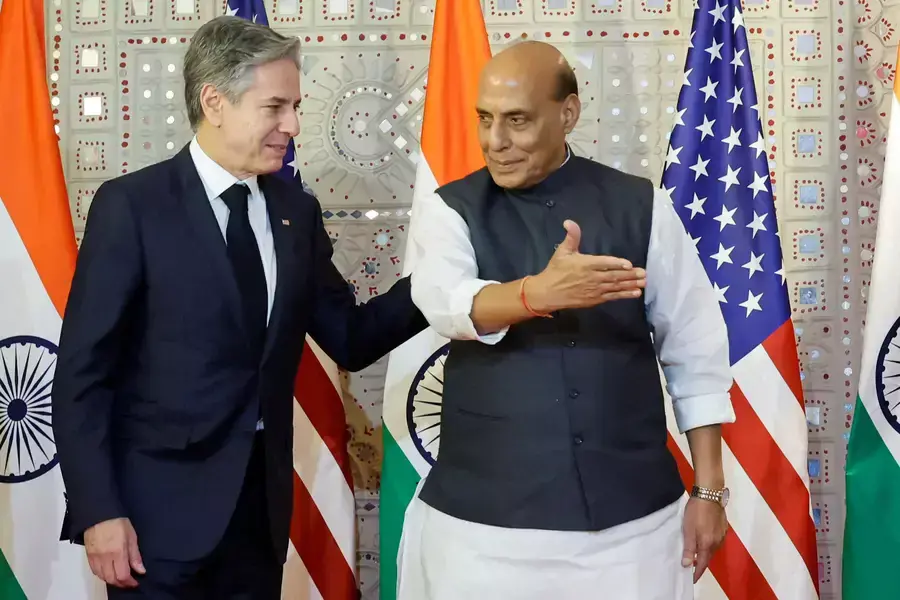Outcomes of the November U.S.-India 2+2 Dialogue

U.S. Secretary of State Antony Blinken and U.S. Defense Secretary Lloyd Austin met with Indian Minister of External Affairs S. Jaishankar and Indian Defense Minister Rajnath Singh in New Delhi on Friday, November 10th, marking the fifth U.S.-India 2+2 Ministerial Dialogue. In the face of global security challenges confronted by both sides, this 2+2 dialogue was intended as a formal follow-up to the meetings between Indian Prime Minister Narendra Modi and U.S. President Joe Biden that took place in June and September of this year. The dialogue discussed a broad range of issues, including Indo-Pacific security, the Israel-Hamas conflict, and the conflict in Ukraine, emphasizing the increasing importance of the bilateral partnership for joint defense efforts and global supply chain securitization.
Though the 2+2 dialogue was anticipated to be a synergic forum, there were certain challenges forecasted for the meeting. For instance, the divergence between the positions of India and the United States on the conflict in Ukraine was predicted to be a point of contention during these talks. The ongoing India-Canada diplomatic rift was thought to present a further challenge. However, both sides’ commitment to the relationship was underlined by their unwillingness to postpone the dialogue despite the United States’ present engagement in the Middle East.
More on:
Central to the meeting’s agenda was the effort to maintain a Free and Open Indo-Pacific. India and the United States not only reaffirmed this commitment, but also finalized the Security of Supply Arrangement (SOSA) to strengthen both countries’ supply chain independence, as well as the 2023 Roadmap for U.S.-India Defense Industrial Cooperation, setting a baseline for defense cooperation and coproduction. Additionally, the two sides agreed to start joint production of armored infantry vehicles.
Another major topic for discussion were the ongoing conflicts in Gaza and Ukraine. During the meeting, India and the United States jointly declared support for a political solution to the conflict between Israel and Hamas. The two countries further called for a humanitarian pause and the continuation of diplomatic coordination with key partners in the region. Both sides pledged humanitarian support for Palestinian civilians in Gaza.
Regarding the war in Ukraine, both India and the United States similarly cited mutual concern over the war’s emerging humanitarian crisis. Notably, the two countries took similar stances on the conflict, drawing attention to the economic impacts of the war in addition to its social consequences. Both India and the United States also pledged humanitarian assistance to Ukrainian citizens.
Political developments in Afghanistan and Bangladesh also came up in the meeting. Indian and U.S. ministers jointly urged the Taliban to preserve Afghan human rights and refrain from using Afghan territory for further terrorist activity, citing United Nations Security Council Resolution 2593 as justification for this call to action. As for Bangladesh, Indian officials stated that it was not India’s position to interfere with or comment on Bangladesh’s “domestic matter.” This comment was made in light of recent U.S. visa restrictions on Bangladesh due to its election practices. When asked about India’s stance on Bangladesh post-dialogue, the United States responded by maintaining that elections in Bangladesh “should be free and open, and...free of violence.” No further comment was made.
The United States and India also touched on relations with China. Tellingly, Indian Defense Minister Rajnath Singh publicly avowed that the two countries were “in agreement” on “countering Chinese aggression.”
More on:
Finally, the two sides discussed strengthening the partnership between India and the United States on semiconductors. Blinken emphasized collaboration in the semiconductor production sector, calling for closer educational cooperation between the two countries. As Blinken stated, this cooperation could be achieved in part through lowering visa wait times for Indian immigrants—an issue important to the Indian government.
Sanjana Sharma is an intern for India, Pakistan, and South Asia Studies at the Council on Foreign Relations.
Clare Harris is the Research Associate for India, Pakistan, and South Asia at the Council on Foreign Relations.
 Online Store
Online Store